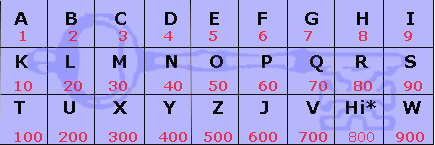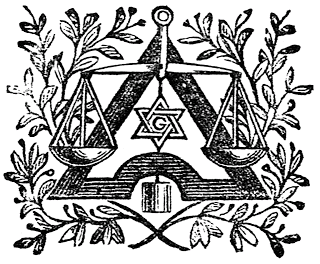Contents
Masonry and the Cabala
The most comprehensive exposition of Literal Cabala published by a Freemason is, The Canon (1897). William Stirling, the author of this work makes it plain that Freemasonry has a deep interest in the Kabbalah:
‘(Qabalah) . . . formed an important part of the Masonic traditions, and undoubtedly contains the nearest approach to a direct revelation of the ancient canonical secrets of the old world;’ (1)
We are also informed that the Brotherhood in its higher degrees is deeply concerned with the cabala. Albert Mackey, in the authoritative Encyclopedia of Freemasonry , asserts that cabala is, ” . . . intimately connected with the symbolic science of Freemasonry,” (2). He goes on to say that:
Much use of it is made in the advanced degrees, and entire rites have been constructed on its principles. Hence it demands a place in any general work on Freemasonry.
More recently, Thomas D. Worrel spelled out, in a paper delivered to the Allied Masonic Degrees Britannia Lodge #303, where in Masonry the Cabala is mainly to be found:
Some of our rites have obvious kabbalistic influence, such as the 28th degree of the Ancient and Accepted Scottish rite which is called: “The Knight of the Sun”. (3)
Albert Pike is yet another well-respected Mason avowing the central place of cabala within the craft. He wrote: “Masonry is a search after Light. That search leads us directly back, as you see, to Kabalah” (4). He also confirmed for us that Kabalah lies at the heart of Masonic cryptography, “All the Masonic associations owe to it their Secrets and Symbols” (5). Pike seems o have regarded Knight of the Sun as an extraordinarily important degree, for he devoted no less than 219 pages of Morals and Dogma to an exposition of it – far, far more than to any of the other degrees (6). The largest single chunk of this chapter is taken up by fifteen pages of a ‘Lecture of the Kabalists’. This starts in the form of a ‘Masonic question and answer ritual’, concerning the numerical mysteries of the cabala, and is prefaced by the words, ‘Omnia in numeris sita sunt’ – ‘Everything lies veiled in numbers’ (7).
Pike tells us that not only is cabala ‘the key of the occult sciences’, but that this key turns on the secret science of numbers – a big hint about the nature of Masonic cryptology.
Brother Thomas Worrel is more explicit than Pike about how cabalistic numerology is employed in practical terms as a cryptic technique, and cites another eminent Freemason in his exposition (8):
Gematria is basically exploring the inner meaning of mystical writings and scriptures by use of numerology. The way it is used is by interchanging letters of special names, phrases, and passages with their numerical equivalent. This is only done with the ancient languages of Hebrew, Greek, Latin, and Arabic. It is thought that the ancient writers were adept at hiding the initiatic wisdom in this fashion. Paul Foster Case (1884 – 1954), a writer, occultist, and Freemason, explains it thus:
Gematria is based on the idea that words having the same value, have correspondences in meaning (9).
The Magical Language is a mode of cryptic writing used to preserve and transmit the practical secrets of the Western Tradition of Ageless Wisdom. It is an artificial language, combining Hebrew, Greek and Latin elements. Its outstanding characteristic is that the letters of the three alphabets it employs serve also as numbers. Consequently, every word, phrase, or sentence is also a number, the sum of the values of the letters (10).
We can see that the artificial language used by the ancient writers to conceal their initiatic secrets was essentially a language of numbers hidden from view, beneath the words, by means of gematria. Gematria is a viable cryptographic technique – and one of fundamental concern to the higher levels of Freemasonry. Some Freemasory’s most enduring secrets are thereby hidden.
A Big Secret
One indicator that we are dealing with a big secret here is the fact that Paul Foster Case’s book is strictly off-limits to the general public. When I enquired about buying a copy with the publishers, Builders of the Adytum (B.O.T.A.), they informed me that it was only available to members of their organization – and only those who had served a fifteen year probationary period. This is extraordinary caution. Clearly there are secrets of great significance revealed in Mr Case’s exposition of ‘the magical language’ of gematria.
At first glance, the secrecy is also rather curious, since there are a good number of books openly published on the subject of gematria, some of which are evidently written by Freemasons. The Canon by “William Stirling” is a prime example. We also find that John Michell, who is the modern editor of The Canon, has written a number of excellent books on the subject: The View Over Atlantis, City of Revelation, The Dimensions of Paradise, etc. Additionally, there are works examining Hebrew gematria, such as S.L. MacGregor Mather’s The Kabbalah Unveiled and those concerned with Greek gematria, like David Fideler’s Jesus Christ Sun of God and Kieran Barry’s The Greek Qabalah.
An example currently displayed online comes courtesy of the J.J. Crowder Masonic lodge in California.
There are some Masonic researchers who think that the letter “G” represents . . . gematria . . . Exploring this technique of letter-number substitution, one looks for words, names, and phrases that add up to like values. Like values are thought to have meaningful relationships. For example, the Hebrew word for “heaven” (ha-shamayim) has the same gematria value as the word for “soul” (neshamah); that is, 395, derived by adding up each letter to arrive at a total. The Qabalist would say this means that the soul is identical with heaven.
This exegetical technique can be used with both the Hebrew scriptures and the Greek Christian scriptures. There are other texts that have been found to contain hidden gematria in Latin and Arabic, as well. From the practice of gematria have arisen extremely interesting techniques, which reveal a type of spiritual Geometry hidden within the Scriptures. (11)
The crux of the matter here, as Sherlock Holmes noted in the dog that didn’t bark in the night, is that something is missing. There has been no credible work ever published on the subject of Latin gematria. We are informed that the subject exists and that it is important, but nowhere is it expounded. Why not? The reason for this omission hinges on the fact that gematria is not confined simply to the ancient languages, as the brethren would have us believe, but also extends to the modern European languages which are based on Roman (Latin) script. Some of the greatest secrets of Freemasonry are hidden in the gematria coding of these languages – not least of which is English.
Nothing Is Missing But The Key
The really big secret is the key: the actual code used. It appears never to have been published and probably so for the reason that any Mason letting the cat out of the bag might expect to have his tongue cut out at the root, his beating heart plucked from his chest and his guts drawn painstakingly through his ears and burnt to ashes before his all-seeing eyes.
How can we find this code?
Like all the mysteries of Freemasonry, finding the key is a matter of following a trail of clues. We saw above that the Masonic degree most closely associated with numerical cabala, or gematria, is the 28th degree in the Scottish Rite: ‘Knight of the Sun’. If we wish to find out a little more about this degree we can go to Albert Mackey’s History of Freemasonry. Here, he tells us that, “Knight of the Sun . . . in its original ritual is a mere condensation of Rosicrucian doctrines.”(12) This is interesting. He then goes on to put the point more forcefully with the words, “There is not in the wide compass of Masonic degrees, one more emphatically Rosicrucian than this.” Mackey seems quite clear about this, and not in the least bit allegorical.
What does he mean by this term ‘Rosicrucian’, and where does it lead? He elaborates when he tells us that Henry Cornelius Agrippa’s Three Books of Occult Philosophy, “. . . may be considered as the text book of the old Rosicrucian philosophy.” (13) It is in Agrippa’s esoteric compendium, published in 1531, that we find the key. The second book of this tome is devoted to numbers and mathematical magic: the eighteenth chapter gives the gematria code of Greek, the nineteenth chapter gives that of Hebrew and the twentieth gives the code of Roman script languages, such as English. Eureka! We’ve found it!
The Missing Key

(* ‘Hi’ is an obsolete letter)
The Right Key?
How can we be sure that Agrippa’s key is the right key? Once again our Masonic writers confirm it for us. “William Stirling” drops a hint like a ripe plum on page 153 of The Canon when he likens the Greek Orpheus to Jesus Christ:
” . . . the name ΟΡΦΕΥΣ has the value of 1275 . . . in the earliest efforts of Christian Art, it is not uncommon to find Christos depicted playing upon a lyre in the fashion of Orpheus. No reason is known for this singular impersonation, but the number 1275, deduced from the name Orpheus, suggests the reason why the two gods had a similar identity.”
The number 1275 in no way suggests any reason why Christos should have a similar identity to Orpheus – at least not until we count the name ‘Jesus Christ’ by Agrippa’s code. If we do, we find the letter values of his name sum as: 600 + 5 + 90 + 200 + 90 + 3 + 8 + 80 + 9 + 90 + 100 = 1275. It is quite clear that “Stirling” is alluding to Agrippa’s code, and it is equally clear from the veiled nature of his reference that it must constitute an initiation secret of high degree Freemasonry.
Now we have the key, we can turn it – and begin to unlock the thesaurus of King Solomon’s Temple.
Leave Your Feedback Below
Submit your review | |
michael joseph ornelas = the-one
= 208 ordinal = birthdate = 10/08/1986 = the-first = est.....
1275=[ 25=(5 squared)] x [51=(17x3)]
25" = Egyptian Sacred cubits in Inches
17 x 2 = 34 = Egyptian Sacred Cubit in digits
It is a very interesting review of Gematria and the interests of the Masonic Lodge in cabala and Hebrew writings. However, I am quite cautious in accepting simple calculations of letters and matching them to other words or letters from which a conclusion is formed. If we are to assume any truth in Gematria, then there has to be a repetitive pattern, and if this pattern is found in numerous examples then we can conclude that it is implying some kind of truth. If it is a one-off example of coincidence, then I fear there is no basis for drawing any kind of conclusion.
Could you please give the source for this quote
(“Masonry is a search after Light. That search leads us directly back, as you see, to Kabalah” (4)
I can see there is a 4 after it but I cannot find any numbers linking to sources at the end of the article. I checked Morals and Dogma by Albert Pike and it isn't in there.
If you want to know the truth ask WARD and JAKOBY!
illuminati ar far away from bright. In Jews they called elohim.
Best Greatings
Tikka

